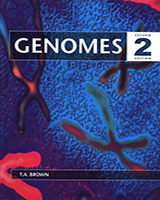Aminoacyl-tRNA synthetases attach amino acids to tRNAs
The attachment of amino acids to tRNAs - ‘charging’
in molecular biology jargon - is the function of the
group of enzymes called aminoacyl-tRNA synthetases.
The chemical reaction that results in aminoacylation
occurs in two steps. An activated amino acid
intermediate is first formed by reaction between the
amino acid and ATP, and then the amino acid is
transferred to the 3′ end of the tRNA, the link being
formed between the -COOH group of the amino acid and
the -OH group attached to either the 2′ or 3′ carbon
on the sugar of the last nucleotide, which is always
an A (Figure 11.4).
Figure 11.4 Aminoacylation of a tRNA. The result of aminoacylation by a Class II aminoacyl-tRNA synthetase is shown, the amino acid being attached via its -COOH group to the 3′-OH of the terminal nucleotide of the tRNA. A Class I aminoacyl-tRNA synthetase attaches the amino acid to the 2′-OH group.
With a few exceptions, organisms have 20 aminoacyl-tRNA synthetases, one for each amino acid. This means that groups of isoaccepting tRNAs are aminoacylated by a single enzyme. Although the basic chemical reaction is the same for each amino acid, the 20 aminoacyl-tRNA synthetases fall into two distinct groups, Class I and Class II, with several important differences between them. In particular, Class I enzymes attach the amino acid to the 2′-OH group of the terminal nucleotide of the tRNA, whereas Class II enzymes attach the amino acid to the 3′-OH group (Ibba et al., 2000).
Aminoacylation must be carried out accurately: the correct amino acid must be attached to the correct tRNA if the rules of the genetic code are to be followed during protein synthesis. It appears that an aminoacyl-tRNA synthetase has high fidelity for its tRNA, the result of an extensive interaction between the two, covering some 25 nm2 of surface area and involving the acceptor arm and anticodon loop of the tRNA, as well as individual nucleotides in the D and TΨC arms. The interaction between enzyme and amino acid is, of necessity, less extensive, amino acids being much smaller than tRNAs, and presents greater problems with regard to specificity because several pairs of amino acids are structurally similar. Errors do therefore occur, at a very low rate for most amino acids but possibly as frequently as one aminoacylation in 80 for difficult pairs such as isoleucine and valine. Most errors are corrected by the aminoacyl-tRNA synthetase itself, by an editing process that is distinct from aminoacylation, involving different contacts with the tRNA (Hale et al., 1997; Silvian et al., 1999).
In most organisms, aminoacylation is carried out by
the process just described, but a few unusual events
have been documented. These include a number of
instances where the aminoacyl-tRNA synthetase attaches
the incorrect amino acid to atRNA, this amino acid
subsequently being transformed into the correct one by
a second, separate chemical reaction. This was first
discovered in the bacterium Bacillus megaterium
for synthesis of glutamine-tRNAGln (i.e.
glutamine attached to its tRNA). This aminoacylation
is carried out by the enzyme responsible for synthesis
of glutamic acid-tRNAGlu, and initially
results in attachment of a glutamic acid to the tRNAGln
(Figure 11.5A). This glutamic acid is then converted
to glutamine by transamidation catalyzed by a second
enzyme. The same process is used by various other
bacteria (although not Escherichia coli) and
by the archaea. Some archaea also use transamidation
to synthesize asparagine-tRNAAsn from
aspartic acid-tRNAAsn (Ibba et al.,
2000). In both of these cases, the amino acid that is
synthesized by the modification process is one of the
20 that are specified by the genetic code. There are
also two examples where the modification results in an
unusual amino acid. The first example is the
conversion of methionine to N-formylmethionine
(Figure 11.5B), producing the special aminoacyl-tRNA
used in initiation of bacterial translation.
The second example occurs in both prokaryotes and
eukaryotes and results in synthesis of selenocysteine,
which is specified in a context-dependent manner by
some 5′-UGA-3′ codons.
These codons are recognized by a special tRNASeCys,
but there is no aminoacyl-tRNA synthetase that is able
to attach selenocysteine to this tRNA. Instead, the
tRNA is aminoacylated with a serine by the seryl-tRNA
synthetase, and then modified by replacement of the
-OH group of the serine with an -SeH, to give
selenocysteine (Figure 11.5C; Low and Berry, 1996).
Figure 11.5. Unusual types of aminoacylation. (A) In some bacteria, tRNAGln is aminoacylated with glutamic acid, which is then converted to glutamine by transamidation. (B) The special tRNA used inin initiation of translation in bacteria is aminoacylated with methionine, which is then converted to N-formylmethionine. (C) tRNASeCys in various organisms is initially aminoacylated with serine.
References
- Hale SP, Auld DS, Schmidt E, Schimmel P. Discrete determinants in transfer RNA for editing and aminoacylation. Science. (1997);276:1250–1252.
- Ibba M, Becker HD, Stathopoulos C, Tumbula DL, Söll D. The adaptor hypothesis revisited. Trends Biochem. Sci. (2000);25:311–316.
- Low SC, Berry MJ. Knowing when not to stop:
selenocysteine incorporation in eukaryotes. Trends
Biochem. Sci. (1996);21:203–208.
- Silvian LF, Wang J, Steitz TA. Insights into editing from an Ile-tRNA synthetase structure with tRNAIle and mucoprotein. Science. (1999);285:1074–1077.
